Environmental Project No. 1276, 2009
Corrected test cases for control of Nord2000-road
Contents
2 Test Cases for a Straight Road
3 Test Cases for a Curved Road
4 Test Cases for a City Street
5 Test Cases for the Yearly Average
Forord
Miljøstyrelsen bad i 2004 DELTA om at udarbejde et sæt af beregningsforudsætninger og dertil hørende beregningsresultater, som kan benyttes til test af computerprogrammer, der beregner vejtrafikstøj efter den nye nordiske beregningsmetode Nord2000. Testeksemplerne blev offentliggjort i Miljøstyrelsens ”Environmental Project 1022/2005”.
I perioden 2005 – 06 blev Nord2000 metoden revideret i et fælles nordisk projekt, hvorved der blev ændret på både beregning af lydudbredelse og på kildemodellen for vejstøj. Siden revisionen af metoden er der desuden fundet mindre fejl i den software, der har været brugt til at beregne testeksemplerne. Derfor har Miljøstyrelsen bedt DELTA om at opdatere beregningsresultaterne for testeksemplerne i den nævnte rapport.
Testeksemplerne er udvalgt i samråd med projektets følgegruppe, og de omfatter alle relevante parametre i beregningsmetoden. For hvert beregningspunkt er det angivet, inden for hvilke intervaller beregningsresultaterne skal befinde sig, for at den testede software kan siges at regne korrekt i henhold til Nord2000.
Målgruppen for rapporten er konsulenter og firmaer, som fremstiller eller markedsfører beregningsprogrammer.
Foreword
The Danish Environmental Protection Agency has in 2004 asked DELTA to develop test examples, which are a set of presumptions together with corresponding computation results, suitable for verifying that computer programmes indeed do perform in conformity with the new Nordic prediction method for road traffic noise, Nord2000. The test examples have been reported in “Environmental Project 1022/2005”.
The prediction method was revised during 2005 – 06 in a joint Nordic project, where both the propagation calculations and the source model for road traffic noise were adjusted. Furthermore, since the revision of the method minor errors have been found in the software used to calculate the test examples. As a consequence, the Danish Environmental Protection Agency has asked DELTA to revise the computation results in the report mentioned above.
The test examples have been selected after consultations with a project steering committee, and the examples comprise all relevant parameters in the prediction method. Intervals have been specified that computation results shall fall within in order for the software to be declared as in conformity with Nord2000.
The target group for the present report is consultants and developers or distributors of software for road traffic noise prediction.
Sammenfatning og konklusioner
Rapporten indeholder testeksempler med forudsætninger for og resultater af beregninger udført ved hjælp af den reviderede nordiske beregningsmetode for vejtrafikstøj, Nord2000. Testeksemplerne skal benyttes ved kontrol af, at computerprogrammer beregner i overensstemmelse med den nye nordiske beregningsmetode. Der er fire grupper:
- Gruppen “Retlinet vej” består af 62 testeksempler for en retlinet vej med trafik i én vognbane og omfatter beregnede værdier af LAeq,24h, LAE og LAmax.
- Gruppen “Vej med sving” minder med 8 beregningspunkter placeret langs en to-spors vej med en kurve mere om et virkeligt beregningstilfælde. Denne gruppe omfatter resultater af beregning af LAeq,24h og LAmax under tre forskellige vindforhold.
- Gruppen “Bygade” har 4 beregningspunkter i bymæssig bebyggelse og omfatter værdier af LAeq,24h i en homogen atmosfære.
- Gruppen “Årsmiddelværdi” omfatter 4 eksempler med årsmiddelværdien af Lden.
Resultaterne er samlet i et Excel regneark for hver gruppe.
Summary and conclusions
The present report contains a number of test cases calculated by the revised Nordic road traffic noise calculation method Nord2000. The purpose of the test cases is to provide a basis for testing software developed according to the new Nordic model. The test cases are divided into four groups:
- The group “Straight Road” contains 62 cases for a straight road with only one lane carrying traffic and includes results of LAeq,24h, LAE and LAmax.
- The group “Curved Road” contains 8 calculation points distributed along a road with two lanes and a turn, looking more like a “real” case. The group includes results of LAeq,24h and LAmax with three wind conditions.
- The group “City Street” contains 4 calculation points in a city street environment and includes results of LAeq,24h with zero wind.
- The group “Yearly Average” contains 4 cases where the yearly average of Lden has been calculated.
The test results have been collected in one Excel spreadsheet for each group.
1 Introduction
The present report contains a number of test cases for which calculations have been carried out by the new Nordic road traffic noise calculation method Nord2000. The model is described in [1], [2], and [3]. The test cases have been elaborated to cover most algorithms of the calculation method. The purpose of the test cases is to provide a basis for testing software developed according to the new Nordic model.
The test cases are divided into four groups:
- The first group denoted “Straight Road” contains 62 cases for a straight road. The test cases cover most parts of the propagation model with the assumption that the terrain profile perpendicular to the road is constant.
- The second group denoted “Curved Road” contains 8 calculation points distributed along a road with two lanes and a turn, looking more like a “real” case. These test cases are based on a former collection of test cases for the old Nordic traffic noise prediction model.
- The third group denoted “City Street” contains 4 calculation points. Three of the calculation points are placed in a street with the same traffic flow, but with different contributions from reflections. The last calculation point is placed in a street situated parallel to the street with the traffic flow, but without any traffic itself.
- The fourth group denoted “Yearly Average” contains four test cases where the yearly average of the noise is calculated. These cases are based on one of the cases for flat terrain from the group “Straight Road”.
The test results have been collected in one Excel spreadsheet for each group.
2 Test Cases for a Straight Road
For a straight road 62 test cases have been developed to test nearly all aspects of the Nord2000 Road Traffic Model.
The horizontal distances in the terrain profile (x-coordinates) perpendicular to the road are measured from the centre line of the road. The road has two lanes, each 5 m wide, and the vehicles are driving in the middle of the nearest lane, and there is no traffic in the far lane.
The vehicles are category-1 vehicles (cars and vans) except in test cases 17 and 18 where vehicles are category-2 vehicles (dual-axle heavy vehicles), and category-3 vehicles (multi-axle heavy vehicles), respectively. In all cases a speed of 80 km/h has been used. The axle width is 1.5 m for category 1 and 2.5 m for categories 2 and 3. The road surface is assumed to be a DAC 12 (dense asphalt concrete with maximum aggregate size 12 mm).
The road is divided into 179 source points placed with constant angle seen from the receiver. The angle resolution is 1°, and consequently the source points cover horizontal immission angles between ±89°.
The results of the 62 cases are given in Excel spreadsheet “TestStraightRoad_20090216” with one worksheet for each test case. (yyyymmdd in the filename is the revision date; yyyymmdd = 20090216 indicates February 16, 2009). An example of a sheet is shown in Appendix A (Test Case No. 1). The main results are:
- The sound exposure level LAE and the corresponding spectrum LE (unweighted) for the pass-by of a single vehicle
- The 24-hour equivalent A-weighted sound pressure level LAeq,24h and the corresponding spectrum Leq,24h (unweighted) for 10,000 vehicles per 24 hours
- The A-weighted maximum level LAmax
- The propagation effect dL (for information, not required in the test process). The propagation effect is the difference between LE and the “free-field” value of LE (disregarding ground and screening effect as well as air absorption).
Besides the results, the sheet contains for each test case the model propagation parameters and the terrain profile given by the distance X from the road centre line perpendicular to the road, the height Z of the terrain, the ground flow resistivity, and the terrain roughness. In addition to the propagation parameters shown on the sheet the relative humidity of the air is 70%.
The 62 test cases for a straight road can be grouped with respect to the terrain shape as shown in Table 1.
Group 1 (flat terrain) contains test cases with variation in ground impedances, meteorological conditions and vehicle category. The remaining groups represent 11 different geometrical propagation cases, and for each group 4 calculations have been made: downwind, no wind, and upwind, all with a receiver height 1.5 m, and no wind with a receiver height of 4 m.
In group 12 (forest) additional parameters are needed to define the scattering zone which is not included in the information given in Appendix A. The scattering zone parameters are defined in Table 2.
Table 1: Test cases divided into 12 groups.
| Group | Terrain description | Test cases nos. |
| 1 | Flat terrain | 1-18 |
| 2 | Flat mixed terrain (varying impedances) | 21-24 |
| 3 | Elevated road, roughness class N | 31-34 |
| 4 | Elevated road, roughness class M | 41-44 |
| 5 | Valley | 51-54 |
| 6 | Valley with a lake in the middle | 61-64 |
| 7 | Thin hard screen on flat ground | 71-74 |
| 8 | Thick hard screen on flat ground | 81-84 |
| 9 | Two screens on flat ground | 91-94 |
| 10 | Non-flat valley-shaped terrain | 101-104 |
| 11 | Non-flat hill-shaped terrain | 111-114 |
| 12 | Forest, flat terrain | 121-124 |
Table 2: Definition of forest parameters in test cases 121-124.
| Parameter | Value |
| x-start | 10 m |
| x-end | 80 m |
| nQ | 0.075 m-1 |
| H | 10 m |
| a, | 0.1 |
| kp | 1.25 |
| atrunc | 0.15 m |
3 Test Cases for a Curved Road
Ten test cases have been included for the curved road shown in Figure 1. The test cases are based on test cases used for the previous Nordic road traffic model given in [4]. The test cases include 8 receiver positions denoted 1 to 8. The receiver distances shown in Figure 1 are measured from the centre line of the road.
The test setup includes a thin and a thick screen. Distances to screens are measured from the nearest edge of the road. The thin screen at Position 3 is 3 m high, and the distance to the road edge is 5 m. The surface of the thin screen has an energy reflection coefficient of 1. The thick screen at Position 4 is 3 m high and 3 m wide, and the distance from the road edge to the middle of the screen is 10 m. For each of the receiver Positions 4 and 5 two test cases have been defined concerning the definition of the thick screen between Positions 4 and 5. In the first case the thick screen is assumed to be a building with vertical facades flat roof and an energy reflection coefficient of 1 (the case numbers are 4-1 and 5-1). In the second case the thick screen is assumed to be an embankment with the same flat top as the building, but sloping faces with a slope gradient of 0.5 (the case numbers are 4-2 and 5-2). The embankment is covered with grass.
The dashed lines in Figure 1 are ground level contours, and the number next to the contour is the ground level in metres. The ground level of the road is 0, i.e. the road is below the terrain surface at Position 1 and elevated above the ground at Position 8.
The road has two lanes, each 5 m wide, and the vehicles are driving in the middle of each lane. The direction of travel is the same in both lanes as the vehicles are driving from South towards North. The number of vehicles is 10,000 per day, and the traffic is distributed equally on the two lanes. 90% of the traffic is light vehicles (category-1) while 10% is heavy vehicles distributed evenly on category 2 and 3. The speeds of the light and heavy vehicles are 90 and 70 km/h and the axle widths are 2.0 m (average of 1.5 m for light vehicles and 2.5 m for heavy vehicles). The number of axles for the category-3 vehicles is 5. The distance between the source points along the lane is 10 m for receiver Position 5, 25 m for receiver Position 3, and 50 m for the rest of the receiver positions. If the lane is higher or lower than the surrounding terrain, the terrain is decreasing or increasing, respectively, starting at the edge of the lane with a slope of 45° perpendicular to the road.
The road is assumed to be extended infinitely at the lower and upper end in Figure 1.
The coordinates of the objects in Figure 1 (road centre line, barriers, calculation points, terrain lines) can be found in the Excel spreadsheet file containing the calculation results (in the sheet “Coordinates”).
Figure 1: Plan view of road and surroundings.
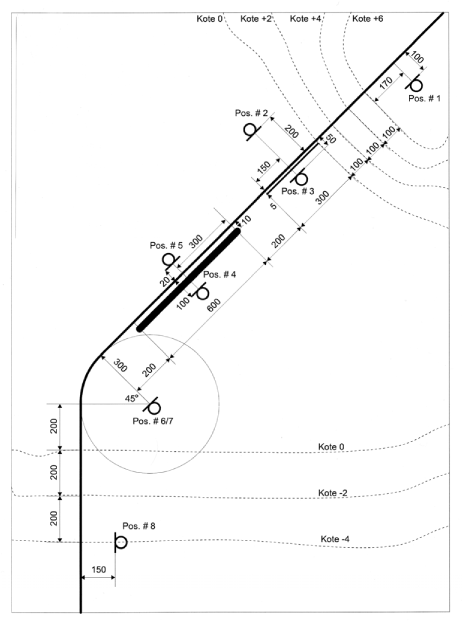
The ground surface is assumed to have a flow resistivity of 200 kNsm-4 (impedance class D) and no roughness (class N). The road surface is assumed to have a flow resistivity of 20000 kNsm-4 (impedance class G).
The receiver height is 1.5 m except in Position 7 where the height is 3.5 m.
The propagation parameters are:
- t0 = 15°C
- RH = 70%
- z0 = 0.05 m
- zu = 10 m
- u = 0, and ±3 m/s
- φu = 315° re north
- su = 0.5 m/s
- Δt/Δz = 0 K/m
- sΔt/Δz = 0 K/m
- Cv² = 0.12 m4/3/s²
- Ct² = 0.008 K/s²
The wind direction φu = 315° indicates that the wind direction is perpendicular to the upper part of the road. A wind speed of -3 m/s indicates the opposite wind direction (135°). Therefore, 3 m/s indicates downwind in Positions 1, 3, and 4 and upwind in Positions 2 and 5.
Results of the 10 cases are given in Excel spreadsheet “TestCurvedRoad_20090216.xls” with one worksheet for each test case. An example of a sheet is shown in Appendix B (Receiver Position 1). For information, calculation results for light and heavy vehicles separately are given in two extra worksheets for each case.
4 Test Cases for a City Street
Four test cases have been included for city streets. Three of the calculation points (Positions 1-3) are placed in a street with the same traffic flow, but with different contributions from reflections. The last calculation point (Position 4) is placed in a street parallel to the street with the traffic flow, but without traffic itself. The calculation points and the buildings important to the sound propagation are shown in Figure 2.
Figure 2: Plan view of city area.
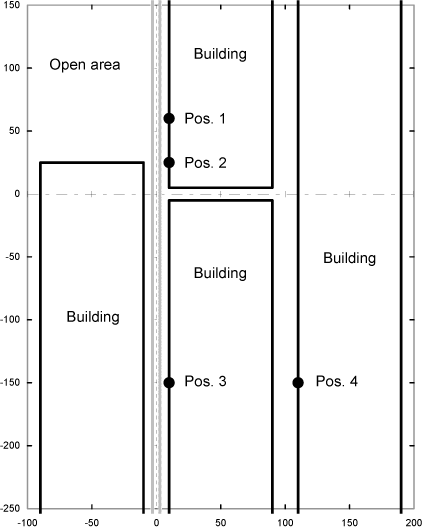
The buildings have flat roofs, and the height of the buildings is 12 m. The coordinates of the buildings, the road centre line, and the calculation points can be found in the Excel spreadsheet file containing the calculation results (in the sheet “Coordinates”).
Calculations have been carried out for an energy reflection coefficient of the facades of both 1 and 0.7. The receiver points are placed at the facades (at a distance of 0 m from the surface) at heights above the road surface of 1.5, 4, and 8 m. The sound pressure level at the receiver point has been calculated disregarding the reflection of the facades at the receiver (“free-field” SPL), but including all first and second order reflections from other facades. If the software to be tested cannot ignore the reflection of the facade, the calculated result of this software has to be corrected for the effect of the reflection (-6 dB or whatever reflection effect is applied in the software to be tested).
The road has two lanes, each 6 m wide, and the vehicles are driving in the middle of each lane. The number of vehicles is 10,000 per day, and the traffic is distributed equally on the two lanes. All vehicles are light vehicles (category-1). The speed is 50 km/h, and the axle width of the vehicles is 1.5 m. The distance between the source points along the lane is 2 m for receiver Positions 1-3 and 20 m for receiver Position 4. Road source points are only included in the calculation when the distance to the receiver is less than 20 times the shortest distance from the receiver to the road.
The propagation parameters are the same as used in the “Curved Road” group described in Section 3 except that a wind speed of zero is assumed (u = 0 m/s).
Results of the four cases are given in Excel spreadsheet “TestCityStreet_20090216.xls” with one worksheet for each test case. An example of a sheet is shown in Appendix C (receiver Position 1).
5 Test Cases for the Yearly Average
Concerning the terrain (flat grass-covered ground) and the traffic, the test cases used for calculation of the yearly average Lden are identical to Test Case 4 in the “Straight Road” group. Four cases of the position of the road and position of the receiver have been included:
- Case 1: The road placed North-South with the receiver East of the road
- Case 2: The road placed North-South with the receiver West of the road
- Case 3: The road placed East-West with the receiver South of the road
- Case 4: The road placed East-West with the receiver North of the road
The method for calculating the yearly average of Lden is described in [5]. The meteorological statistics to be used in the calculations can be found in the Excel spreadsheet file containing the calculation results (in the sheet “Met. statistics”).
Lden is calculated for 10,000 category-1 vehicles each day throughout the year, and the vehicles are distributed on day, evening, and night time by 7889, 791, and 1320, respectively. The vehicles are driving in the middle of the lane nearest to the receiver, and there is no traffic in the far lane.
The results of the 4 cases are given in the Excel spreadsheet “TestYearlyAverage_20090216.xls” with one worksheet for each case. An example of a sheet is shown in Appendix D (Case 1).
6 Acceptable Deviation
To check whether a software provider has implemented the Nord2000 prediction method correctly, all the test examples in this report shall be calculated.
The overall A-weighted sound levels (LAeq,24h, LAE, LAmax) shall not deviate by more than 1 dB from the calculated results in any example specified in the present report. In most cases the deviations can be kept within 0.5 dB. Deviations exceeding 0.5 dB should therefore give rise to increased awareness concerning possible errors in the software under test, and the reasons for the deviation should be explained.
The calculated third octave band spectra shall be compared to the third octave spectra in this report. Deviations less than 1 dB are in general acceptable for the sound level values in each frequency band. Deviations exceeding 1 dB in one frequency band shall be investigated. Special problems may occur at ground effect dips in the frequency spectrum where the uncertainty may increase. A shift in the dip may lead to a considerable sound level difference in a frequency band close to the dip. A shift in the dip frequency of one third octave will in general be considered acceptable in such cases.
The length of road section actually included in the calculations will affect the calculated results, and particularly the calculated spectra may be sensitive to variations in the length. In group 1 and 4 an infinitely long road is assumed in the calculations and in group 2 and 3 a section of 40 times the shortest distance to receiver is included for practical reasons. If possible, this should be simulated in the software to be tested. Otherwise higher deviations must be expected depending on the actual length of the road section.
7 References
- H. J. Jonasson, Acoustic Source Modelling of Nordic Road Vehicles, SP Report 2006:12, Borås 2006.
- B. Plovsing, Nord2000. Comprehensive Outdoor Sound Propagation Model. Part 1: Propagation in an Atmosphere without Significant Refraction, DELTA Acoustics & Vibration, Report AV 1849/00 (revised), Hørsholm 2006.
- B. Plovsing, Nord2000. Comprehensive Outdoor Sound Propagation Model. Part 2: Propagation in an Atmosphere with Refraction, DELTA Acoustics & Vibration, Report AV 1851/00 (revised), Hørsholm 2006.
- Road Traffic Noise – Nordic Prediction Method, Tema Nord 1996:525, Nordic Council of Ministers, Copenhagen 1996.
- R. Eurasto, Nord2000 for road traffic noise prediction. Weather classes and statistics, VTT Research Report No. VTT-R-02530-06, Esbo 2006.
Appendix A
Reference is made to the Excel spreadsheet ”TestStraightRoad_20090216.xls”
As an example, case no. 1 is shown below.
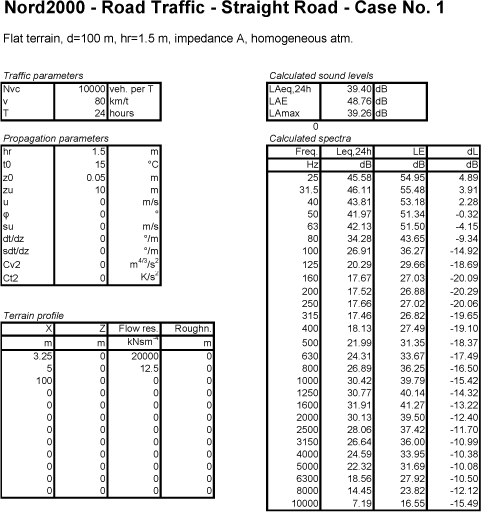
Appendix B
Reference is made to the Excel spreadsheet ”TestCurvedRoad_20090216.xls”
As an example, receiver position 1 is shown below.
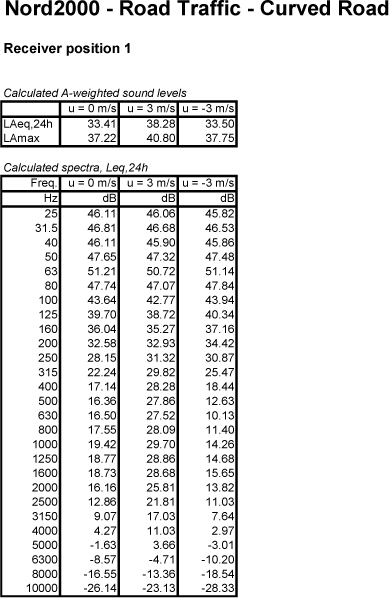
Appendix C
Reference is made to the Excel spreadsheet ”TestCityStreet_20090216.xls”
As an example, receiver position 1 is shown below.
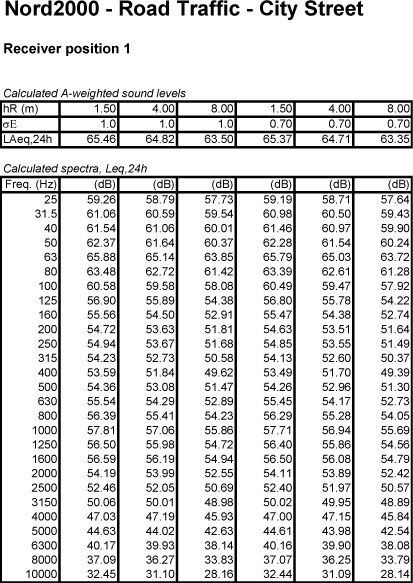
Appendix D
Reference is made to the Excel spreadsheet ”TestYearlyAverage_20090216.xls”
As an example, case no. 1 is shown below.
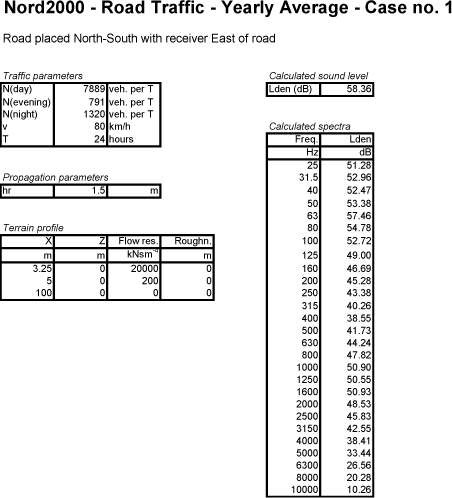
Version 1.0 Marts 2009, © Danish Environmental Protection Agency